By Lambert Strether of Corrente
The augmentation of the complexity and intensity of the field of intelligent life –Ursula Le Guin, The Left Hand of Darkness
Yes, it may be snowing and bitterly cold where you are — or, alternatively, you may be getting that miserable kind of rain that happens slightly above freezing where big drops somehow get under the hood of your anorak — and it’s certainly still more and more depressingly dark day by day — the winter solstice, when the light turns upward, is still almost a month away, falling on December 22 this year — but you can still fight back against the cold and the dark: You can order seed catalogs![1] And then, you can plan your garden!
Most of what follows is from email that alert reader pq threw over the transom, and which I’ve lightly edited. I found it really inspiring (and also wildly ambitious by my standards; I’ve been w-a-a-y more incremental, mostly because it took me awhile to figure out what I really wanted. Tomatoes were, of course, my gateway plant, but I ended up abandoning vegetables entirely in favor of flowers). The photos are also by pq; I had asked for a photo, and this was pq’s response:
[pq:] I don’t think the NC community’s expert gardeners are going to be very impressed with any single photo. The awesomeness is in the evolution of a neglected, left-for-dead side yard of a rental building into a living, breathing space with butterflies, bees, fat earthworms, and toads, not to mention flowering plants. The space is about 11 x 38.5 ft. The garden idea started forming when a friend gave me some root divisions of bleeding heart last fall. I needed a place to put them and asked the landlord if I could plant them along the fence.
Here is the “neglected, left-for-dead side yard”:
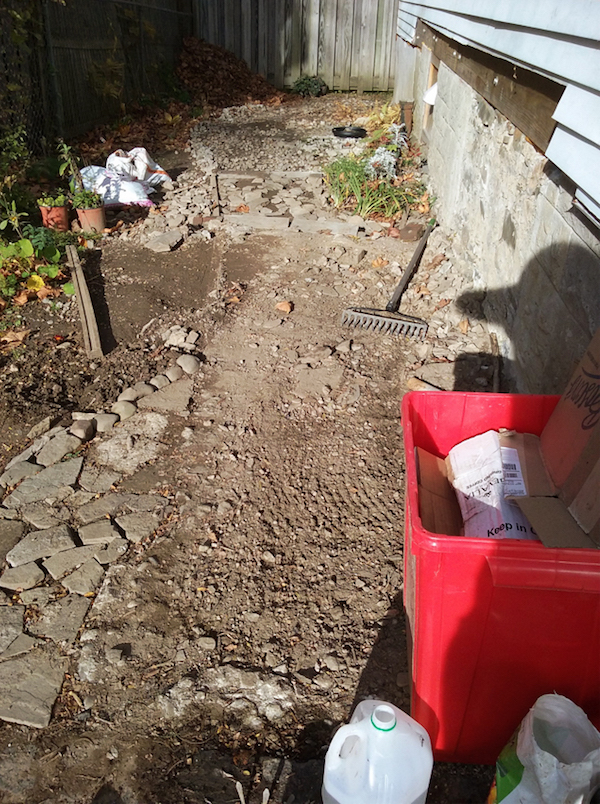
Here are the bleeding hearts that started it all:
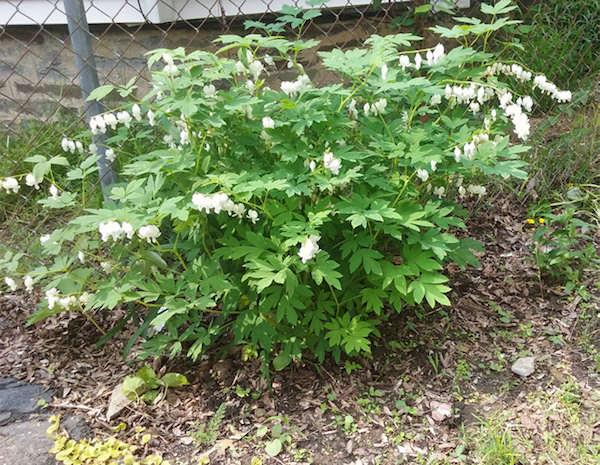
[pq:] When they came up huge and luxurious in the spring, I asked if I could put more plants along the fence. I dug a border of about a foot and a half and began yanking out weeds. The root systems were impressive. They had grown so thick and entangled that they effectively had formed an impermeable barrier under which nothing could survive. They even were suffocating themselves. There were no earthworms. I became obsessed with weeding. Hours at a time, day after day.
I have never been obsessed with weeding; I am a lazy gardener. But I do like a project of turning a patch of nothing into soil by ripping out useless roots.
[pq:] Then I began turning the soil. The ground along the fence had benefited some from years of accumulated leaf deposits, but starting about two feet out, I hit hard clay. And rocks! In some areas, whole layers of what looked like river rock, mixed with shale and some weird composite stuff. When I mentioned it to the landlord, he knew all about it. The previous owner (his father-in-law) had built a deck, with a big stone staircase, but the deck was rotting into structural supports of the building and threatening to bring down the entire house (built in 1901). My landlord got a crew together, tore out the deck and staircase, and installed a new support beam. And guess what they did with all that rock?
As I unearthed rocks, I separated them into piles according to size and shape and began thinking about what I could do with all this free landscaping material.
The sorted rocks:
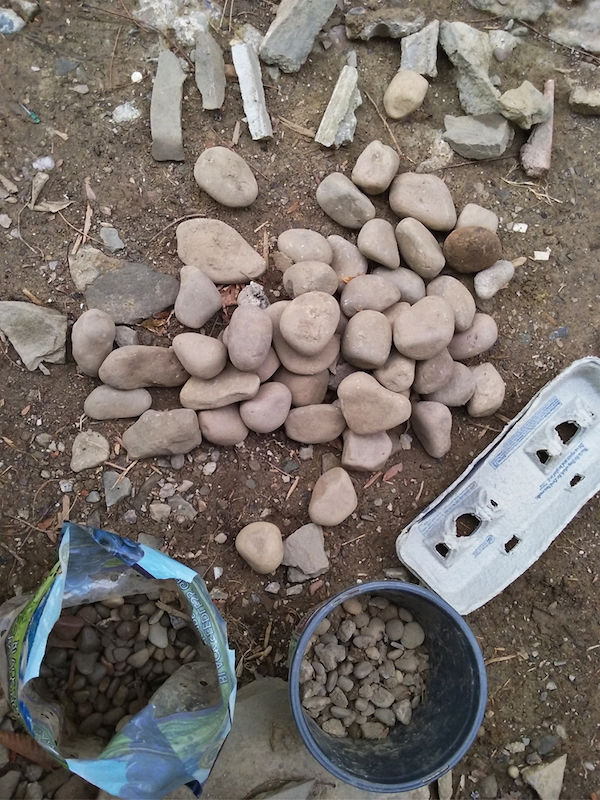
[pq:] I had to have a path through the garden, not only to tend the plants, but to allow my downstairs neighbor to access the garbage dumpster. Initially, I thought I’d get some mulch and make a path like in a photo sent in by an NC reader. But as the rock piles grew, it was a logical conclusion that they were meant for the garden path. Configuring them was another story, though. I ended up spending more of the summer and early fall laying rocks than anything else.
This is the permaculture principle of using what comes to hand. In my first couple of years, I put in a number of rock borders. Then over time, as rocks will do, they sank into the soil and disappeared! It was always a pleasure, when digging to create something new, to discover one of my rocks. Then I could repurpose!
[pq:] I did have lots of plants, though. I got many of them for free, some from neighbors, some from the roadside, including milkweeds. I regularly visited the rescue plant section at the back of Lowe’s garden center[2]. I also started some from seed, found in the 25-cent bin at Dollar General. I think I sent you some photos of the “wall” of nasturtiums and morning glories that I trained to climb the ugly chain-link fence separating our yard from the run-down side of the property next door. For all practical purposes, that was my “first-year” garden.
The wall of morning glories and mastershalums:
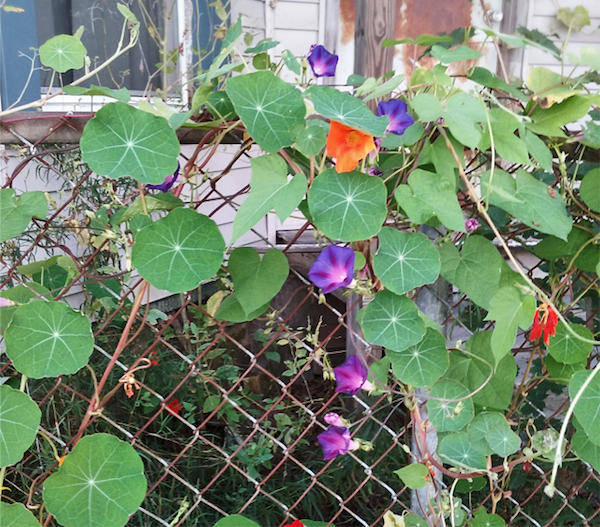
[pq:] As summer ended, I faced two major challenges: 1) to build the soil, with no money; and 2) to get it all done before the first freeze. You actually provided my soil solution with your “sheeting” linkI couldn’t follow it 100 percent, as I already had some plants in the ground (being broke doesn’t help), but I had some good sources of material. I collected all the suitable cardboard my neighbors put in the recycling bins. Starting in September, leaves were free for the raking. I had a little manure and organic fertilizer from last year’s container gardening. My landlords, thrilled that they no longer had to maintain the side yard, brought me a big bin of sawdust mulch, which they get ridiculously cheap from a sawmill just outside the village. As I said, not really the “right” way to do sheeting, but much of the soil is already vastly improved since spring. Before the weather turned cold, I had to be careful not to step on all the earthworms! A fleet of bumblebees were still busy at work while I was raking leaves in late September.
(See NC here on “sheet mulch”.) I would urge that worms are the best possible soil amendment; if you didn’t have worms, and now you do, that’s a great victory. With worms and the leaves and the sawdust, I bet pq’s soil will get all nice and soft and crumbly — even, given time, the clay.
[pq:] I was struggling to stay ahead of the weather…. And then we got that blast of arctic air and the ground was frozen solid for more than a week. I may be able to work a little in the next few days, but at this point, I’m pretty much resigned to pausing until spring. Writing about it will be my winter “garden project.” I’ve attached a few photos, just to give you an idea. I never took a real “before” shot, because I did a lot of work before realizing there WAS a before. In early June, before I started, the downstairs neighbor came through with a weed whacker. That was the last time. From then on, I was the One Weed-Whacker; there were no other weed-whackers before me.
Here is a look up the garden path:
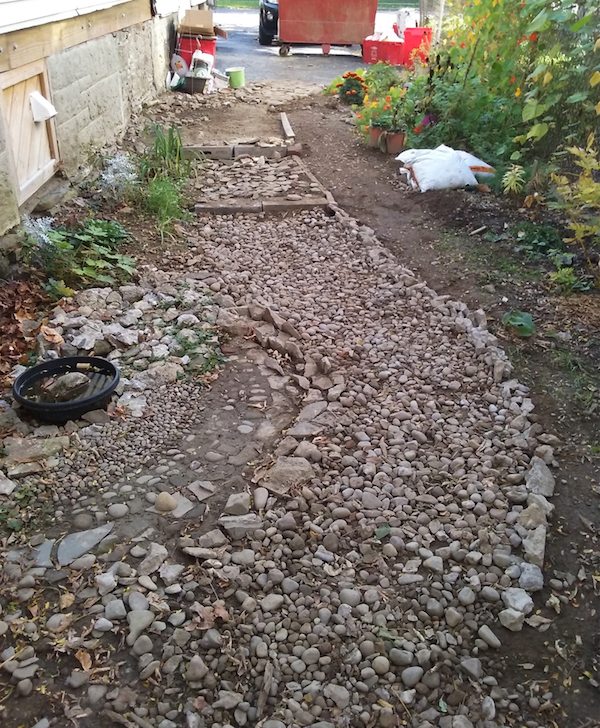
[pq:] Anyway, thank you for asking! This garden was beyond therapeutic; it saved my life. And you and the NC “Garden Club” unknowingly had a hand in it.
pq also included the plan of the garden:
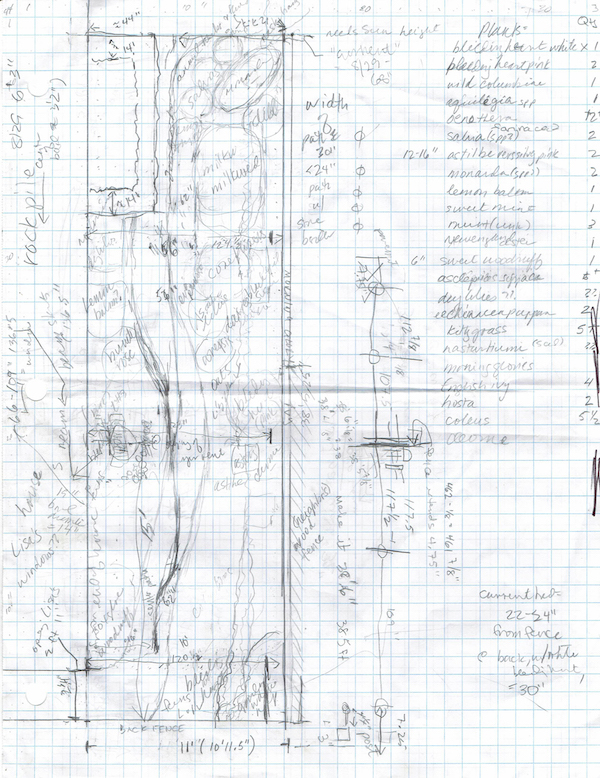
I found that touching, because I remember finding my father’s plan for a garden in the side yard, pinned to the wall of his workshop. He had the beds all laid out, but never got to it. I never did make a plan (and his plan would not have been mine).
I don’t know of I can add much to pq’s account, save to ask you to share your own experiences of gardening — or to consider starting your own, if you are in a position to do so. Something to look forward to. So order up your seed catalogs and make a plan
NOTES
[1] From experience, I recommend Johnny’s Seeds and Fedco in Maine. They have excellent seeds and they are both co-ops (fruits of the back-to-the-land movement in the Sixties). I would bet there are other companies around the country with seeds that are best for your particular region.
[2] I understand the economics, but garden centers also spread disease. Be careful! I never had any bugs in my garden at all when I grew exclusively from seed. This is vegetables; flowers may be less susceptible.


territorial seeds is my go-to…and whatever i find at a couple of mom and pop nurseries who are hep to localism.
and i save seeds like a crazy person…got a long skinny paste-type tomato that my grandmother first purchased seed for in the 50’s… no idea its real name, it’s been called “that long skinny paste tomato” for as long as i or my mom can remember.
i also run off with cuttings from herbs and interesting plants pretty much wherever i go…and usually have pocketsfull of acorns, and such in the fall.
the pastures on this place were stickerburrs, cacti and sand when i got here…now, after 25 years of stealing grass seed from the side of the road, it’s diverse and lush even without timely rains.
all i’m lacking is a good source of non-herbicidal manure…planning on calling the horselady after thanksgiving, to remind her of my existence, and see if she has a large enough accumulation of horseshit to justify a trip.
i reckon pq is as much of a radical revolutionary as i am…matters of degree, and all.
remake the world, beginning at your doorstep.
and it’s good for one’s soul, as well.
“we must cultivate our garden”-Voltaire
> the pastures on this place were stickerburrs, cacti and sand when i got here…now, after 25 years of stealing grass seed from the side of the road, it’s diverse and lush even without timely rains.
Guerilla gardening!
Well, you could be the one to name it. You could call it “skinnylong paste” or some other name you feel is suitable.
as the oldest grandchild, i had the privilege of naming the grandparents…although i have no memory of it.
i gave her the name “Gagoo”…which stuck, and was ever after used by all and sundry.(she wore it with pride, to her great credit)
so we often call it “Gagoo’s tomater”.
not sure what the marketing department thinks of that.
How about ” Gagoo’s skinnylong paste”? Marketing will love it! It just radiates authenticity.
And, here in Tucson, it’s Native Seeds SEARCH. Or the Pima County Library’s Seed Library.
Another great place is Seedsavers https://www.seedsavers.org/
They have many heirloom flowers and vegetables. I planted their pollinator seed packets in an area next to.my house. I had flowers blooming all summer, along with butterflies and bees. I’d post photos If I could.
Pq, congrats on a good-looking path, beautiful bleeding hearts and for reuse and free seeds and starts. Thank you for sharing your photos.
Clay isn’t necessarily bad; it has good minerals and holds moisture whereas sandy soil does not.
West Coast Seeds in Vancouver Canada is also good.
In California, try Theodore Payne for native plants, ships within California only.
https://theodorepayne.org
Not having a car now seeds and worms are the only way to go for me. I have to make do with what I have as far as soil, so building that has been a huge and ongoing project here in high mountain desert country. ( Fortunately I got trees while I still had a car.) Someone at local Walmart branched into af. violets this summer – most languished there, but not to worry – take the decrepid looking ones on sale and install in your progeny’s no longer in use fish aquarium (minus the water of course). Beautiful long lasting color to brighten your winter.
I have a canary, so greens for him are planted in cutdown milk cartons on the west windowsill. Cold when the curtains get closed but they are thriving – dwarf blue kale from seed can be planted sequentially and snipped regularly. Winter sun is all they need.
Outside, all my saved plastic tubs and tublets get the leafage except for a light garden sprinkle – more around the roses. The tubs go on tillaged areas so worms can enter and feed on warm days, slightly set in. (Can be lifted to remove slugs congregated there also – whoever said slugs don’t gather where there are worms was off his/her rocker.) In the heat of the summer these tubs are my tomato and squash containers – it gets hot and dry here, easier to keep containers watered. Huge tubs are main compost wallcorners ongoing. My worms never starve~ have a huge population now.
Lovely post and kudos to gardener Ursula! Bonus to containers is many come into my sunroom for the winter – especially cherry tomatoes and small chile plants – I even actually have an orange ripening this year – one! – after ten years saying I was going to chuck that orange tree. Progress!
Ah, memories of the colorful Burpee’s catalogue from childhood…
Since our garden areas are pretty well established, I’ve resorted to allow any perennials to winter-over with their inflorescences intact .. as in not deadheading, for 2 reasons. First is that leaving the plants intact allows them to better harden-off, thus making survivability through the harsh winter months a surer thing. They can always be pruned back in the spring, once frost danger has passed. Secondly, any viable seed from said plants .. and this goes for annuals & biannuals as well .. can be allowed to sit all Winter, to stratify, making germination easier. By close observation, one will be able to id and choose what to keep (Free Plants – Yay !!), and what to rogue out. I have a variety of sages that I’ve planted in close proximity, which I hope have cross-bred. So who knows .. some surprizes might spring up next year, or two. We also save some vegatable seed if it’s something we want to continue growing – squashes, tomatoes, potatoes, onions, etc .. I haven’t had much in the way of disease or pest issues when buying plant starts … the nursery that I frequent sells good qualtity stock. And, believe it or not, there’s ALWAYS going to be disease & pests lurking – part of Gaia’s web .. the best experiance is to not mono crop, plant for diversity .. and let the beneficial insects do their work, knowing that there will be the occational ‘sacrificial’ plant here and there – That’s Life, right ??
> not deadheading
As a lazy gardener, I do not deadhead. And you give good reasons for my practice!
One could think of a reason to deadhead for a while. Deadheaded plants will keep flowering for a while longer, and that keeps them feeding bees for a while longer. Then one could let the last relay of flowers for the season of that plant go to seed.
I cut back the things that turn into floppy messes (daylillies, hostas), but leave everything else. I was amazed to see that the new bee balm that I planted in September perked up after several days with low temperatures in the single digits.
Lovely garden. I love the rock borders.
I want to put a plug in for Baker Creek Heirloom Seeds: rareseeds.com. They have all sorts of neat stuff!
+1
The Gettle family is an inspiration. I enjoy their seed catalogue every year.
For Atlantic Coasters, the Vesey’s seed catalogue from PEI is great. I order in February and have never been disappointed the next spring.
i already have my Dixondale Farms onion catalog and my Stoke’s Seeds commercial growers catalog (i’m not commercial, but i give a lot away, enough to merit ordering larger quantities of seeds)
Pine tree garden seeds is in Maine and I order from them and territorial most years but try to get as much as possible from the local seed/ garden store. Pine tree had smaller packets for home gardeners and many varieties that are recommended here by the u of mn. So pretty short season/zone 3-4 type stuff.
For fruit bearing trees and bushes I like
https://www.raintreenursery.com/
Exotic varieties suited for Pacific and NW, well packaged for shipping and high quality.
I meant to say this.
When making your plan, if it is your first plan, think not in two dimensions (beds alone) but three: Beds plus canopy, and plant some trees.
It took me five year from tomatoes to filbert trees, and if I had planted trees in my first year, they would have been bearing in three (as opposed to eight, the way it worked out).
four dimensions…considering time and succession.
eventually, the biggest pecan tree that the squirrels planted will provide too much shade for that particular garden/yard for anything but leafy greens and mints. it will also shade the greenroom attached to the house in summer, then loose leaves in fall, allowing sun in, helping heat the house.
some of the other squirrel-planted pecan trees, along the west fence, will give just enough shade to make those beds more productive. july, and especially august and september, are pretty hard core around here…and right now, they are pretty much useless after july.
in other west fence beds, the pear trees provide a different profile of shade(columnar), and the blackberries on that fence(newly replaced, 6 foot stock panels) will protect from the after 5pm blaze, while allowing unimpeded sunlight the rest of the day.
here, unlike in …say..maine…when the seed package says “full sun”, one must take it with some circumspection. none of the seed companies live here,lol.
Yes, I’ll vouch for Raintree as well. I’ve ordered, and planted several grape varieties, sour cherries, and medlars … the fruit of which are bletting in cool storage .. to be made into pepper jelly. Raintree most definately is a great fruitree/bush/vine source.
Baker Creek is great. They have Molokai Purple sweet potato slips in the spring. They love the conditions in Phoenix, but they are also about the quickest maturing sweet potatoes I have seen so they would probably work in borderline northern territory.
Not wishing this to degenerate into a seed exchange, but does anyone have a source for Thompson Broccoli? The last time I was able to get new seed was two years ago, and I’ve come up with nothing in days of searching on the internet. Any pointer would be appreciated . . .
All I have found is that Territorial Seed used to carry it but no longer does. Might be worth dropping them an email to ask about it.
What was Thompson broccoli like? What were its special visible and/or growth features? What were its special benefits and uses?
Big, tightly bunched heads; long season of maturing; hardy against cold and heat; best tasting broccoli (in my opinion, of course). And when it runs to seed late in the fall, the bees love attending the late flowering. Open-pollinated, of course.
Got’s me a little patch in-front of my cottage. If you have a craftsman home, you need a little garden. Almost a requirement. So I ordered a pound of wildflower seeds from Garrett Wildflower Farm. I’ll admit, I’m not growing much to eat but I really, really want to fill my small front yard with flowers. Eleven species and I wasted nearly all the seeds on a small patch. Let’s hope a good number make it.
> a pound of wildflower seeds
I buy several pounds. I find that surrounding the garden proper with white clover is a good defense against deer (combined with black fishing line). They stop and eat the clover, and go no further. (Deer, a pest, are both stupid and near-sighted).
You can also buy seed by the pound that is optimized for beneficial insects, or for shade. Generally the selection will allow for succession, so there are always new species blooming.
Wow. The garden looks like it was a lot of work, but what an improvement.
As far as seeds I have had good luck with Johnny’s, Territorial seed & Eden brothers. If you are local to Oregon, I might suggest looking into Siskiyou Seeds. Their seed CSAs are a great deal especially if you go in with a friend or ten to share the seeds and like to guerilla garden. I also like peace seedlings for their unique varieties and adaptive seeds open pollinated, organic. I’ve used the wild flower mixes from Silver Falls Seed Co. This early spring I threw ~ 1/4 in of compost over a section of my gravel driveway I wasn’t using. Then spread a packet of wildflower seeds and let nature take its course. Instant garden! Here it is Nov, we’ve had weeks of subfreezing nights a tiny dusting of snow and there are still flowers blooming, mostly calendula at this point. Still a nice bright edible decoration on top of the salads of mostly greens that are coming out of the veggie garden at this point.
I didn’t find Thompson Brocolli on a search of Dave’s Garden, but you might try posting the question in the forum.
I have attended the NOFA-NY winter conference every late January in Saratoga Springs for the last few years. For the last 3 years there has been a parallel Organic Seed Companies conference semi-associated with the NOFA-NY conference at the same time and place.
At those conferences I have met some seed company people whose tiny companies do not send out catalogs. They only have an online presence. But they seemed extremely interesting and worthwhile.
One is Fruition Seeds based in Finger Lakes country of New York State. Short-ish season adapted Northerly-ish oriented varieties. Website here for perusal and judgement.
https://www.fruitionseeds.com/
The other is a single individual named Joseph Lofthouse, based in Utah. He came all the way out to NOFA-NY conference, which is some kind of vote-of confidence. His deal is breed-mixing back from pure varieties to landraces. He explains what he means by that in his literature. Here is his basic website. http://garden.lofthouse.com/ A few minutes study of the website reveals how to find his seed lists, link to a set of blog-articles he wrote for Mother Earth News Magazine, and some other things.
Looking at the “seed listings”, I see that Mr. Lofthouse has gone out of the seed selling business to focus his time energy on breeding and other things. He writes that he will make a few seeds available through the Experimental Farm Network, which his “seed listing” link links to. 2-3 varieties available, the other hundred plus not available any more.
Sometimes a window suddenly slams shut.
regardless…that’s a cool site!
landrace gardening…hybrid swarm breeding!
http://garden.lofthouse.com/hybrid-swarm-breeding.phtml
lots to chew on, there.
thanks!
ive mentioned it before….curcurbits grow super well here…my county is famous for watermelons and especially cantaloupes.
i grow a lot of squash(especially spaghetti squash)
…and save seeds.
but there’s a native gourd…curcurbit foetida…the seeds are edible after charring only—with actual fire. raw/dried, they have a caustic chemical that will burn up your insides.
i’ve worried for a long while about accidental crosspollination of that trait to my squashes.
but i’m too ignorant about it to either prevent it, or to know if it’s even something to worry about.
Oh Fruition is out of Naples! Awesome! I will throw a few dollars their way. Thanks for the heads up!
This post made me emotional. Back in the day, My wife and I lived in a crappy apartment in Chicago where we had access to a cement patio surrounded by a chain link fence. The neighborhood was such that I couldn’t even leave a little bbq out there because someone would climb in there and steal it (I once actually saw a guy running down an alley with a lit Weber). There was a strip of dirt about a foot wide and 10 feet long under one section of the fence, next to a playground, and I decided to brighten up our dismal place by making a tiny garden there. I could only think of a few things that would climb and cover the fence. Morning glories and peas. Started in late winter (about end of April in Chicagoland) and by mid-summer, had only a few low plants. I did the same a year later, but added some tomatoes grown from seed indoors and dahlias that I bought from a place called Gethsemane on Clark. Dahlias got ripped out by someone. The peas and morning glories climbed halfway up the fence and the tomato about 2 feet tall. In September, I had 1 lonely tomato. Our upstairs neighbors saw it and came to our apartment with a basket of tomatoes from the guy’s parents garden. I was so touched.
Frankly, that tiny garden kept me going in some very difficult times.
Dahlias got ripped out by someone, eh? If that happened to me, I would certainly “think about” replanting dahlias and when they got near to ripout-size, painting them with poison ivy oil. ” What!? Poison ivy oil helps plants grow! How was I to know someone would pull them out?”
A while back, I contributed a little DailyKos diary about my gardening efforts to a DK group focused on gardening and sustainability. There are a couple of before/after shots of our Rust Belt urban yard along with the tale of my conversion from Miracle Grower to permaculture enthusiast.
This is my first year trying a garden in my backyard, and so far it’s been a howling success. Thanks to some timely rains in South Texas in May, I had tomatoes, ancho and poblano peppers, and some Thai basil for the summer. Since our winter growing season has started, I have a forest of kale (three varieties), cilantro and waiting for spinach, cauliflower and broccoli to come up. I’m looking to clear more of the Bermuda grass to make room for more veggies and I like the wildflower idea. We’re going to try keeping some bees in the spring.
“narrowcasting”:
Here’s a source for Purple Milkweed seed (my recent experience with an Etsy seller was disappointing — the plant was common milkweed but as the plant did not bloom the first year it took me 18 months to discover that the seller (interpreting sympathetically) did not know what he was selling):
https://www.prairiemoon.com/asclepias-purpurascens-purple-milkweed-prairie-moon-nursery.html
If you want this plant, order the seeds asap as they sell out quickly (2 seed pack, about 60 seeds total, limit per customer). And follow the cold-treatment instructions that come with the seeds.
Prairie Moon also sells Cardinal Flower, which is an effective hummingbird attractor.
If you are into native plants, I recommend the North American Native Plant Society, http://nanps.org. I have been converting all my (tiny) front yard to edible plants. It is anchored by periennials — honeyberries, currants, a pear tree (no pears so far) and many herbs, milkweed, and some kale that came back from last year — very tender. I fill in with annuals, the big hit this year was self-seeded lambs quarters, it just showed up last year and I let it stay. High in minerals, easy to harvest, bug- and drought-resistant, good cooked, raw or pickled, the seeds are plentiful and edible, too. Grows like a weed, since it is a weed.
We moved the Meyer lemon indoors, where it will spend the winter in the bathtub. This is the second time it has bloomed. It didn’t set fruit last time, although I tried pollinating it with a Windsor Newton 0 brush. This time it was outside for the blooms and the *real* pollinators were able to work their magic on it and (tada!) there are some tiny lemons on it. Maybe this time.
The backyard has an apple tree and a mulberry tree and two young maples. I am trying to convince grapes to climb the back fence and blackberries to share the corner with the forsythia.
I plan to try to rooting cuttings from my fruit plants and a couple of neighbours have said I can take cuttings from their elderberry and quince bushes. Free plants! If it works.
Thank you, pq, for your work and for documenting your garden’s growth. And, thank you, Lambert, for publishing it. If all we accomplish during our years on Earth is to turn our small patch of ground from a desert into a flourishing garden, then we will have lived a successful life. As opposed to those who turn great swathes of our Planet into Wastelands and die clutching the crumpled dollars they have accumulated.
And, pq, I am so happy to have discovered another ‘rock sorter!’
Well, I hate all you people. I have vast cultural resources literally a subway ride away, but my gardening patch consists of two indoor windowsills and two outdoor: one outdoor one has a window box full of sweet woodruff flanked by 2 very tired Whole Foods primroses and the airshaft windowsill has 3 individual pots of Christmas cactus plus a miniature purple rock iris–oh, and a struggling pot of Alsatian bluebells on the bathroom windowsill, which I may repot in hopes of seeing some improvement. At best I get north light; I’ve given up trying to grow pots of anything but shade plants–small shade plants, at that.
I grew up in a family of gardeners, but with the death of my mother and the closing up of her backyarded house some years back, my horizons are considerably narrowed. I’ve got a shelf or so of inherited gardening books, including some beautifully written garden books by Henry Mitchell–which I absolutely recommend for long winter months when nothing’s doing outside.
By the way, anyone have a reliable source of live plants by mail? (For the next time I’m feeling a little lucky)?
My favorite seed sources (I grow in Montana, Zone 3/4) are:
Seeds of Italy — distributes Franchi seeds, oldest seed company still going. Everything grows beautifully and they have several interesting greens: https://www.growitalian.com/
High Altitude Gardens (great source of short-season tomatoes, many of them Siberian in origin). Now part of Seeds Trust: https://www.seedstrust.com/
Evergreen Seeds for Asian greens and vegetables. (Kitazawa Seeds are also good, but considerably more expensive than Evergreen) http://www.evergreenseeds.com/vegetableseeds.html
Seed Savers Exchange for my annual dreams of finding the perfect tomato for my short season (although I think I’ve already found it — Jaune Flamme): https://www.seedsavers.org/
Johnnys Seeds for pretty much everything else, including good prices on row cover in bulk. https://www.johnnyseeds.com/
Everyone should also check their local library. More and more of them are adding seed and tool libraries – and if yours doesn’t, there’s a great project for learning more about your local gardening scene.
I’m going on 18 years in this garden — I’ve rebuilt the beds a couple of times, and have nearly achieved my dreams of a closed-loop system with the addition of a couple of hens. Before that, I gardened in all kinds of side yards and recycled bins and window boxes in crappy apartments from NYC to SF. Growing something, even herbs and cherry tomatoes in pots is so good for the soul.
What a heart warming thread. Especially as I have to leave my beloved acreage and small herd of goats after almost 20 years here in Northern NSW for family reasons.
We are moving to inner city North Adelaide where we will have a courtyard garden and a shared community garden two minutes walk away. The mediterranean climate will be better for herb and vegetable growing – none of the moulds and grasshopper invasions which plague aspiring vegetable growers here in the humid subtropics.
As written by Joni Mitchell, and sung by CSNY 50 years ago:
“We gotta get back to the garden”….
Lets hope that radiation from the soon to be rolled out 5G network does not derange and destroy bees and other insects as some well informed people are predicting.
Originally I came to NC for the analyses of the financial crisis, then came back for the cool-headed Brexit coverage. But I stayed because of posts like this. Thank you Lamberth, for lifting spirits and making us think of spring!
My chili seed collection started when I was travelling in Asia. I took a long break off of work, and travelled (mostly by train) from Europe through Ukraine, Russia, Uzbekistan and Kyrgyzstan to China and Mongolia, then Philippines and Indonesia.
In every country I tried to find vegetable and fruit markets, and I bought chilis, dried the seeds and when I got home, in Europe, I started growing the plants. It’s so wonderful to grow these plants from seed, watch them develop from almost identical seedlings into all these different chili varieties. That autumn I made jams and sauces, and gave lots away to friends. Over the years I’ve been collecting and growing more, from Mexico, Peru, Surinam and other places, and often friends bring me seeds as well.
I sow indoors, and put the plants out on the balcony in April or so. I wish I had a greenhouse! Even a small one would be great, because overwintering these plants inside my flat has been difficult. I also dream of a garden! So far it’s been balcony-style urban gardening.
I know it’s a bit obsessive, focussing on one plant like this, but they are truly varied, and you always have something with which to spice up your home cooking. It amazes me that these plants, originally from Mexico and the Amazon, have become such a staple of other cuisines, like in Asia. Cheers to chilis!
Here is an interesting article about what plants survived someone’s own particular experience with drought.
Perhaps worth considering as people decide what seeds to get.
https://www.resilience.org/stories/2019-12-05/what-survives-a-drought/